Need I Say Core?
Our story begins many years ago at the very first R&D hackathon. The hackathons are an exercise we do in R&D where we take the week off from our normal responsibilities and focus exclusively on a task for a week. The goal of the first hackathon was to find more innovation products (it's a slot we do every year which has included things like Conspiracy, Planechase, and the Un- sets). The "winner" of the hackathon would be selected for the 2019 innovation product slot. That would end up being a product that Ethan Fleischer and I proposed—what we pitched as Time Spiral 2, a supplemental product with a higher complexity level aimed at more enfranchised players. This is what would become Modern Horizons. But today's story is not about that hackathon team.
Today's story is about a different hackathon team lead by Doug Beyer which was interested in finding a more beginner-friendly way to draft. Limited play has always had an interesting dilemma. Not having to make a deck ahead of time is a big bonus for a new player who might be intimidated by the sheer act of selecting 60 cards to make a deck, but being faced with a slew of new cards you've never seen before and making a 40-card deck proved equally intimidating. The goal of Doug's team was to find a way to get someone playing quicker and easier.
Doug's big idea, what he proposed to get a hackathon team in the first place, was a draft where the player only had to make a few decisions. His vision was a draft where you drafted not cards but themed groups of cards. For instance, you didn't take a Goblin, you drafted a bunch of Goblins.
One of the things I don't talk about very often is that people hold ideas with too high of a reverence and execution too low. A great idea is a wonderful thing, but if you can't find an execution for it, it's useless. This was the challenge of Doug's hackathon team. The idea was great, but how to execute it was a giant challenge. What exactly did it mean to have a "bunch of cards"? How were they grouped together? What kind of themes did they need? How exactly did you produce such a thing and put it into a booster pack? After a week of exploration, Doug's team found an answer, but it required printing and packaging technology we didn't yet have. At the end of the hackathon, Doug's project was put into the "we like it, and maybe one day we can execute on it" box.
Flash forward to the vision design of Core Set 2021. Doug had kept fiddling with his project since the hackathon, and it was decided that the best way to execute it was to tie it to a core set. Jumpstart, as the product would ultimately get called, would need a lot of cards, and many of them would come from the accompanying core set. Meanwhile, the set's lead vision designer Aaron Forsythe was excited to use this core set as a way to bring back a bunch of exciting and interesting reprints. On top of all that, this was going to be the first booster set to participate in Booster Fun, and they wanted to find a way to do something exciting that fit the nature of a core set. Aaron and his team had a lot to figure out.
The Core You Know
Let's begin by walking through what the Vision Design team had as a starting point.
It was following in the model of Core Set 2020.
This meant a couple things. First, there wouldn't be any non-evergreen keywords. For a while, the core set had played around with bringing back a keyword each set, but with the return of core sets after their hiatus, this was dropped. Second, it would have a light theme, most likely tied to a face for the set. Core Set 2020 used Chandra. Core Set 2021 would need to pick a different Planeswalker. Finally, the set would be a mix of new cards and reprints. The new cards could be individually flavorful cards or possible cycles with connected mechanical themes. The reprints could be anything that Play Design was okay with letting into Standard. This would be the area to grab Aaron's interest.
It had to work with Jumpstart.
This was the biggest challenge of the design. It had to work with something Magic had never made before. Doug and his various teams had solved many of the problems, but there was a lot left to solve and part of that was using Core Set 2021 as a tool to solve them. This meant the Core Set 2021 design teams (Vision Design and Set Design) had to put together their set in such a way that it gave Jumpstart many of the cards it needed to function.
It had to have a cool Booster Fun element.
While this was a normal core set, something had changed since last time we'd made one. Throne of Eldraine introduced Booster Fun (you can read more about it here), a series of alternate frames and art that got added to each set. Like all sets, Core Set 2021 would have borderless planeswalker cards, depicting Planeswalkers with new art that goes all the way to the edge of the card, and extended-art frames, a selection of rares and mythic rares with art extended to the border of the card. (Borderless planeswalkers can be found in Draft Boosters, but extended-art cards are only found in Collector Boosters.) It would also have what we call showcase cards, cards with a special frame and art tailored to the set. Throne of Eldraine had the storybook cards, for instance. Part of building Core Set 2021 was finding a cool opportunity for the showcase cards.
Aaron, and later Adam Prosak, Core Set 2021's lead set designer, had to solve all these problems. Let's walk through how they did it.
Someday My Reprints Will Come
Aaron started by thinking about how he could make this core set stand out. Aaron didn't have what most premier sets get, a world and theme to build around, but he realized that with the absence of a world also came certain advantages. Often, for example, reprints are tricky to get into sets because they have to match the creative of the world and the mechanical themes. A core set didn't have that problem. Aaron would be free to reprint any card he wanted. So that's where he started, by thinking about what cool reprints he could put into the set. What exciting things from Magic's past could be added to Standard?
Aaron and his Vision Design team (Doug Beyer, Mark Heggen, and himself) poured through old sets looking for cool candidates. They were aggressive in their choices. With each one, they'd go to Play Design and talk about what it would mean to Standard to bring that card back. This challenge would get passed along to Adam and his Set Design team (Sam Stoddard, Yoni Skolnik, Corey Bowen, Donald Smith Jr., Andrew Brown, and Ari Nieh) who took up the gauntlet.

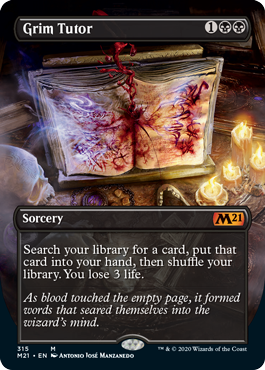
Two of the more aggressive choices, Ugin, the Spirit Dragon and Grim Tutor, were handed off from Vision Design, but Set Design also found a bunch of cool reprints. (Note the ones I'm showing are just the ones that have been spoiled so far. There are other reprint goodies in the set.)
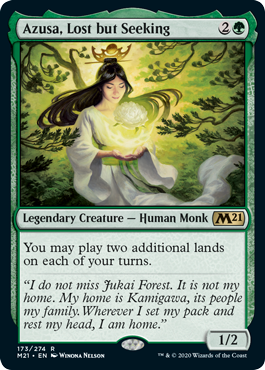

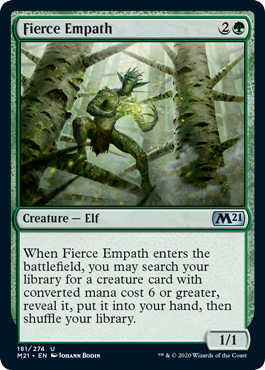
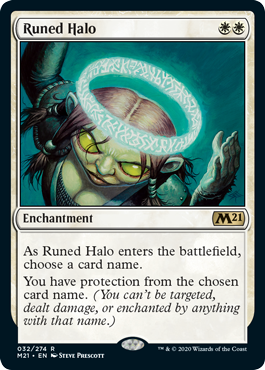
Aaron also appreciated that the core set served two very important functions. One, it allowed cool top-down designs that didn't need to fit into any larger context. All the designers on Core Set 2021 were pushed to design cool cards that could be exciting in a vacuum. Second, it allowed R&D to make cards needed for the larger metagame. Was there a theme that a former set pushed, but it didn't quite make it into Standard? Well, a core set can make a card or two to help push that theme. In particular, it's fun to push themes that will be rotating out come Zendikar Rising, as it lets you be a bit more aggressive. Aaron's Vision Design team and later Adam's Set Design team would do a lot of work to fulfill both functions.
You Say Jumpstart
To understand the needs of Jumpstart in Core Set 2021, let's first explain what exactly Jumpstart is. Each Jumpstart booster comes with a pack of 20 cards. The cards are usually of one color, have the appropriate and correct percentage of basic lands, and have a theme. They are wrapped inside a see-through packaging inside the booster packaging and have a front-facing card (not a Magic card) that identifies the theme. The idea is that you grab any two boosters and combine them to make a playable 40-card deck. Another popular way to play Jumpstart is to open twice as many boosters as you have players and then take turns drafting opened packs, meaning you get to see the theme of each bundle. (The recommended draft is a snake draft where everyone drafts one pack, then the last drafter picks a second pack and you go in reverse order for drafting the rest of the packs.)
This meant that Jumpstart needed themes. A lot of themes. Jumpstart has 121 different bundles you can open and many of those bundles can have various configurations. (I should also note that some themes show up in multiple boosters with different card mixes.) The Jumpstart design team spent their time figuring out what themes were available, but they had to work with the Core Set 2021 design teams as many of the cards they were going to use needed to come from Core Set 2021.
Here's how this played out. The Jumpstart design team would say to the Core Set 2021 design team, "We want to make a Cat-themed bundle. How many Cats do you have, and what colors are they in?" The M21 team would say something like, "We have four Cats in green, one in white, one green card that makes Cat tokens, and a land that can affect Cats." The Jumpstart team would then look at what reprints were available (they also had license to design a few new cards) and see if they could make a Cat bundle. If they couldn't, they would come back to the Core Set 2021 Set Design team and say, "We're shy two Cats. Any way you can add a few more Cats in green?"
Be aware that this wasn't just happening with one theme, it was happening with a whole mess of themes simultaneously. Every time the Set Design team made a change, they had to consult with the Jumpstart team to make sure they weren't causing problems. In the end, Core Set 2021 shared 120 cards with Jumpstart. All of these cards have a Core Set 2021 expansion symbol on them and are playable in Standard.
I've Been Framed
What to do with the showcase cards was another challenge the Core Set 2021 design teams had to solve (along with the set's Art team). The big question was how to do something that played up what a core set is about. What's something key to the essence of a core set? Interestingly, while that problem was being solved, another problem also came to the forefront. Core Set 2019 had Nicol Bolas as the face. Core Set 2020 had Chandra. Who was going to be the face of Core Set 2021? Clearly, it wanted to be a Planeswalker, but who?
After much internal debate, it was decided to be Teferi. He had joined the Gatewatch during the Nicol Bolas story, and we felt it was time for him to get the spotlight. The Core Set 2021 Set Design team decided to use a slightly lighter touch with Teferi. Unlike Chandra who got three planeswalker cards in Core Set 2020, it was decided to just give Teferi one planeswalker card. (There are a bunch of variants though for the collectors out there.) They then looked at who Teferi knew to pick some of the legendary creatures for the set. For example, one person very close to Teferi gets a legendary creature card for the first time in Core Set 2021.
The core set always has a cycle of monocolored planeswalkers (well, since planeswalker cards were a thing), so that meant Teferi would be the blue planeswalker. (Teferi, as a character, is white-blue, but he is base blue as his magic is time based, a blue thing.) This led to the discussion of who the rest of the Planeswalkers should be. Red and black were kind of obvious, as the core set tends to use the best known Planeswalkers. That meant Chandra and Liliana. Green was a little more open. We had the choice of Vivien, Nissa, or Garruk. Vivien had just been in Ikoria, and we had other plans for Nissa, so that left Garruk. Luckily, he had just lost his curse in Throne of Eldraine and was back to mono-green. It felt right to have Garruk back in the core set.
That, of course, left white. We had some options (Ajani, Elspeth, etc.), but we thought this would be a good place to introduce a new white planeswalker. Someone to fill the void left by Gideon's death. This new Planeswalker, named Basri Ket, happens to be part of my preview today. By the way, if you want to learn all about this new Planeswalker, we have an article about who he is, complete with his (pretty cool) backstory. You can read it here.
Because Planeswalkers are a big part of any core set, the Core Set 2021 Set Design team decided to do something cool with them. They designed a vertical cycle. That is, they made a mythic rare planeswalker, a rare spell, an uncommon spell, and a common spell that all did two things. One, they thematically matched the Planeswalker, meaning they were all spells the Planeswalker would cast. Two, they mechanically connected them, so you'd want to play them together. My preview today is Basri Ket and his vertical cycle of spells.
Click here to see them.
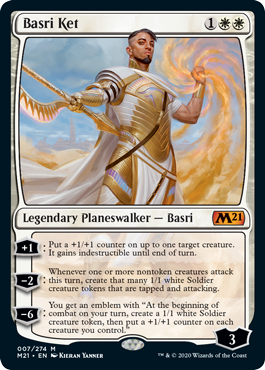
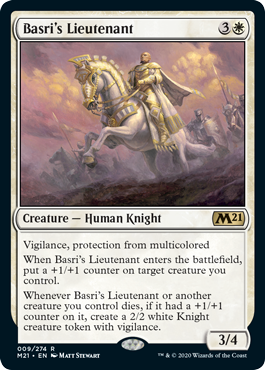
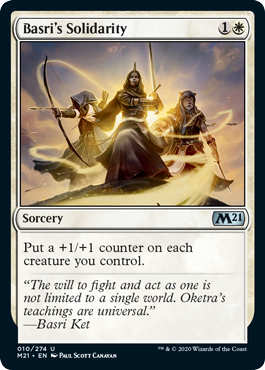

As you can see, Basri plays around with a +1/+1 counter theme that is woven through all his spells.
Often when you solve one problem, you also solve another. Once there was a cycle of Planeswalker vertical cycles, the Set Design team and the art team realized they had something they could build showcase cards around. Here's what they did. For each of the five monocolored planeswalker cards, they built a unique frame, something that captured the essence of the character and their magic. They then took all four cards of the vertical cycle, plus the appropriate basic land, and made a showcase version. Here's what Basri's frame looks like.
Click here to see.

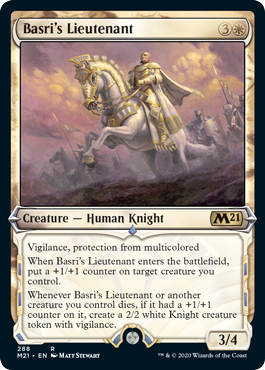
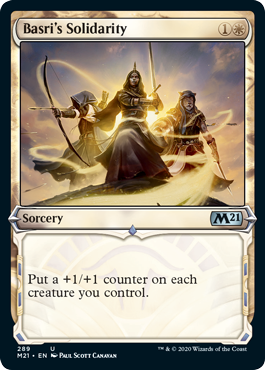
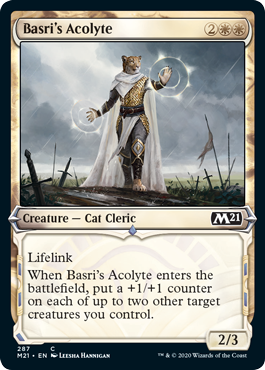
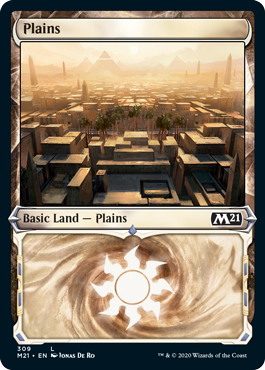
We've already shown you several of the other Planeswalkers' vertical cycles, but let's put a few of them together to get a view of how their frames differ.
Click here to see them.
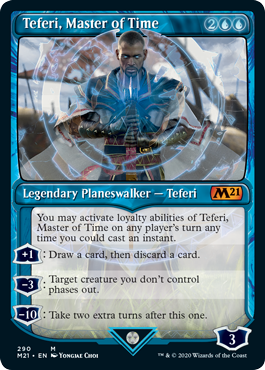
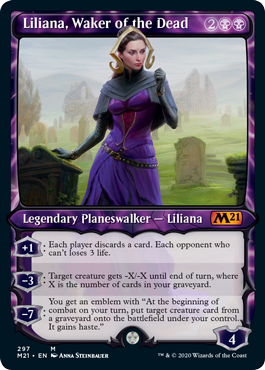
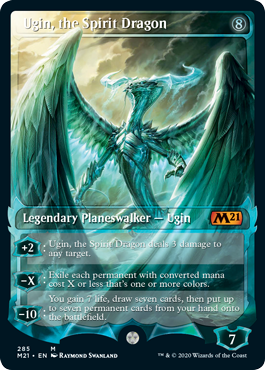
You'll notice Ugin gets a showcase frame. As he was a planeswalker card in the set, it seemed only fair he got one. Unlike the other five Planeswalkers, though, he doesn't get a vertical cycle.
Core to Come
That's all the time I have for today. I'll be back next week with more goodies from Core Set 2021. I hope you enjoyed today's article. As always, if you have any feedback, I'd love to hear it, so please email me or contact me through any of my social media accounts (Twitter, Tumblr, Instagram, and TikTok).
Join me next week for more Core Set 2021.
Until then, may there be cards I showed you today that you're eager to play.
#746: Brian Tinsman
#746: Brian Tinsman
34:23
Brian Tinsman spent many years designing Magic cards and led sets like Rise of the Eldrazi and Time Spiral. He and I chat.
- Episode 744 Erik Lauer
- Episode 743 Mark Heggen
- Episode 742 Brian Weissman

